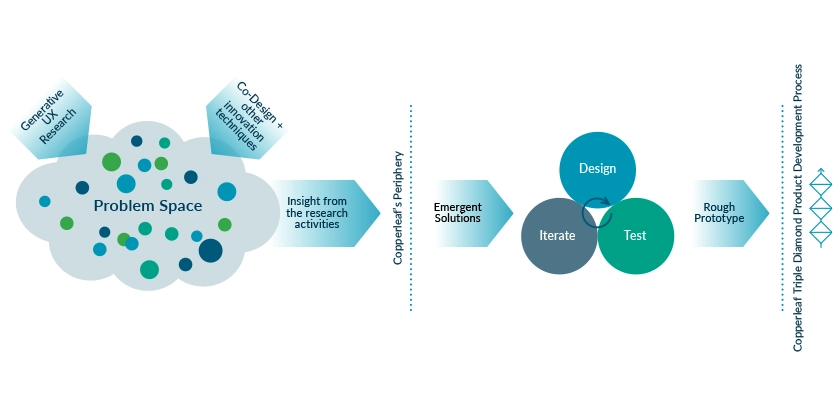Guest Post: Balancing Idea-led and Research-led Innovation (Part 1)
At Copperleaf®, we know that choosing what to focus on next is one of the most important decisions we make for our business and for our clients’ success. When looking at new ideas, it’s important to find the balance between different approaches in order to lead us to the best innovations. In this article, Innovation Research Consultant Karyn Zuidinga explains idea-led and research-led innovation and identifies the risks and benefits of these approaches.
Idea-led Innovation
For most product teams, the product development process begins with an idea to address a problem. We then evaluate the viability of that idea and then validate it. Eventually, after some iterations, we launch it. This process is known as ‘idea-led innovation’ or an ideas-first approach. It’s widespread and looks something like this diagram:
Ideas-first approach to innovation and product development. Adapted from Itamar Gilad’s ‘How Much Product Discovery Is Enough?‘
Idea-led innovation is compelling. It tends to be fast and if the idea is good enough, you can innovate quickly. Copperleaf has had plenty of success with this approach with both large and small features in our product suite.
The Risk of Failing Slowly
For many organizations, speed is a significant driver of the ideas-first approach. In theory, you’re “failing fast” by getting something out there quickly, seeing if it works, and then adjusting it. If your initial idea is solid, chances are it will land well in the market and you’ll have a successful innovation. But if the idea isn’t quite right, you could be stuck with something that you need to put resources into maintaining and tweaking, but has no real traction in the long term. Once the product’s in your client’s hands and they start using it, it’s almost impossible to take it away from them. You can wind up failing very slowly and expensively. The trick is knowing that the idea will land well. But how do you do that?
Research-led Innovation
To mitigate the risk of failing slowly, a UX researcher might say, “But wait, we should examine the user’s needs first! Let’s look beyond the ‘known problem’ to see if we discover unknown or unmet needs. Let’s do ‘blue-ocean’ or generative research.”
This kind of exploratory research can be very successful and has resulted in substantial breakthrough innovations.
Research-led innovation begins by exploring a problem space and then using research methods such as generative user research and co-design sessions to create effective solutions. Our team can develop these solutions into rough prototypes, and if viable, the nascent product can enter into the standard product development process.

The process of research-led innovation
Because this process comes before the typical product development process, it’s called Phase Zero. In an ideal world, we’d always begin with research-led innovation.
The Business Case
Research-led innovation can be a hard sell in most organizations because:
- It can take a very long time
- It’s challenging to do well
- It’s messy and the outcomes are uncertain
- We often enter into it without a clear problem statement
- As the problem statement gets defined, the boundaries tend to blur, and we can get stuck in endless loops
For all the reasons above, it’s sometimes hard to make the business case to spend time on research-led innovation. So it falls by the wayside, and designers and UX researchers get stuck doing evaluative or validating research. We sometimes end up doing a ton of usability testing and tweaking potentially bad ideas.
So what is a UX researcher to do? In the next part of this blog series, I’ll share a story about trust, collaborative leadership, and finding the balance between idea-led and research-led innovation.


